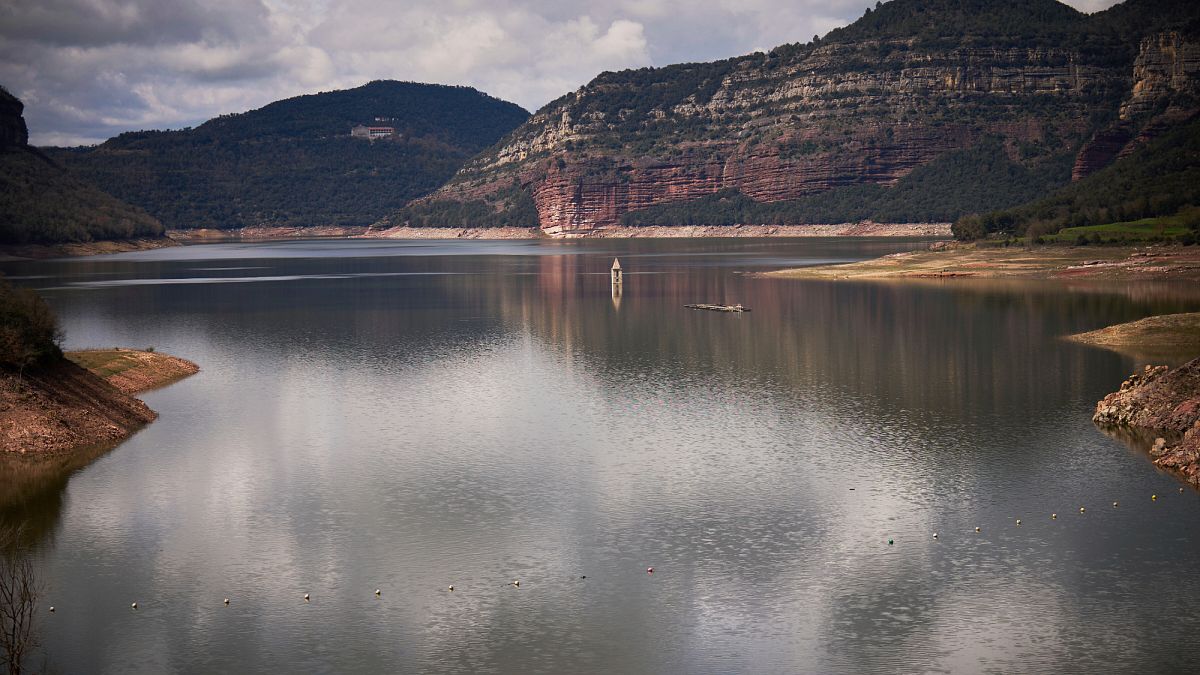Oregon
Video: Masses of Dragonflies Migrating Along Oregon Coast
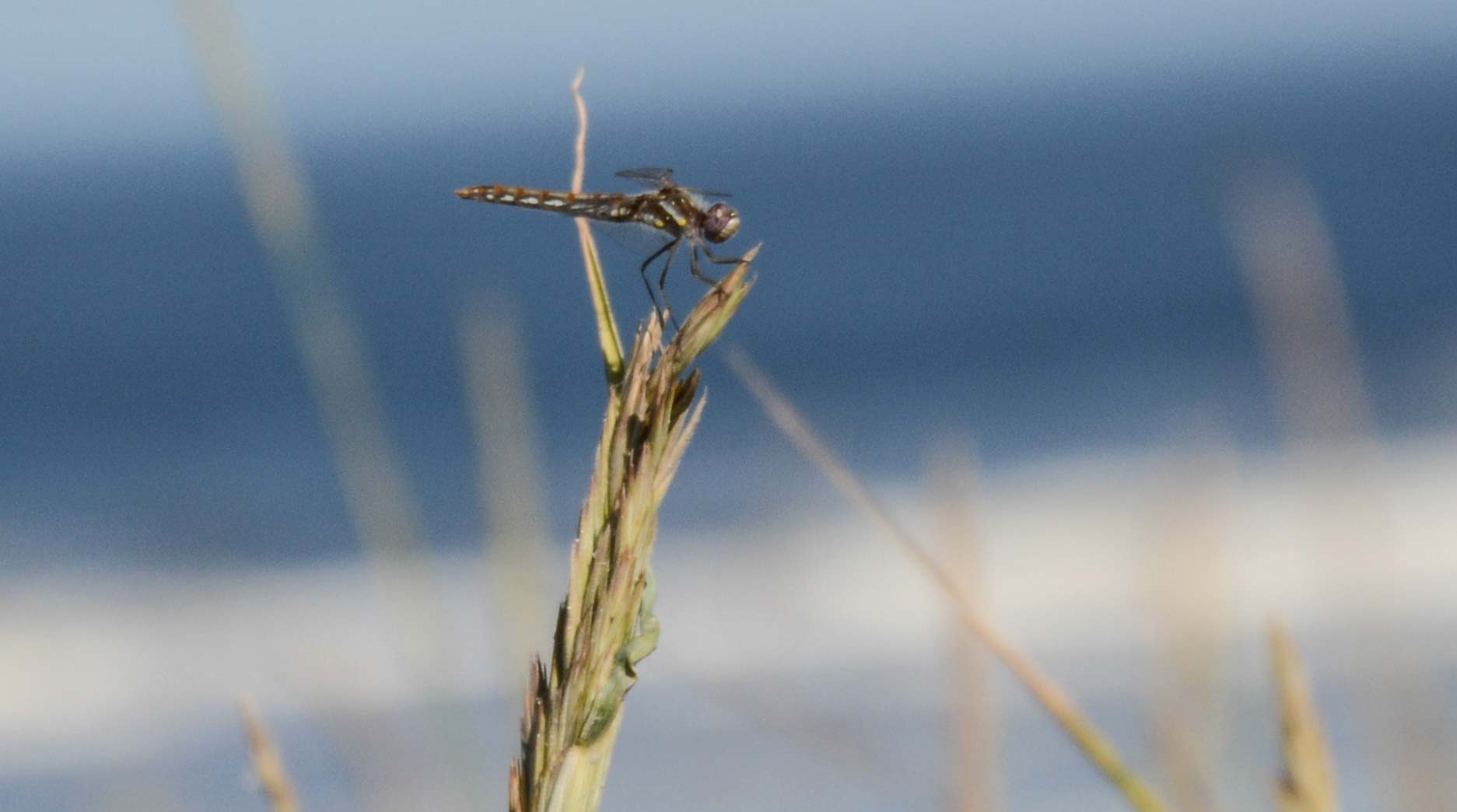
Published 08/13/23 at 9:31 p.m.
By Oregon Coast Beach Connection staff
(Oregon Coast) – Thousands of dragonflies are making their way along the north Oregon coast right now, according to Seaside Aquarium, which just captured some amazing images of the little creatures flitting about en masse. It’s a migration that happens apparently yearly, but many years it goes on unnoticed or at least not in great numbers. Other years, like right now, it’s quite a sight, sometimes creating large walls of them. (Above: photo Tiffany Boothe / Seaside Aquarium)
The aquarium’s Tiffany Boothe documented the current run, which often happens when there’s a lot of east winds coming in – as there is now with the sizable heatwave. She even snagged video, which has not been obtained much in years past.
“The dragonfly migration is on! Thousands of dragonflies are currently migrating through the dunes,” she said.
Boothe caught them at Del Rey State Recreation Site just north of Seaside.
The dragonflies being found are the variegated meadowhawk, which tend to engage in their big migrations a little later in the season than this.
During some events, variegated meadowhawk are seen in huge numbers in multiple places, sometimes swirling together in giant formations. Periodically, estimates have them at around 28 to 36 dragonflies a minute. Oregon Coast Beach Connection has covered this in the past, noting they would pop up in Rockaway Beach, Newport and Seal Rock all at once, and even Seaside all at once – then be gone after a day or two.
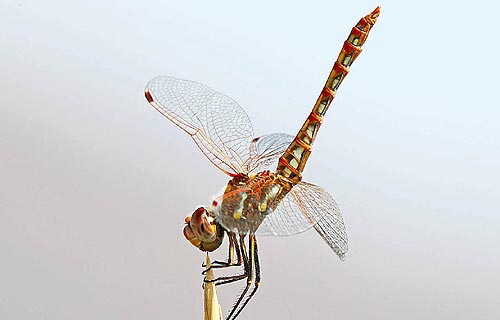
Photo of the variegated meadowhawk OSU
Several years ago, Steve Gordon and Cary Kerstgon talked to Oregon Coast Beach Connection about a particularly large run then. They wrote the book Dragonflies and Damselflies of Oregon, considered the definitive work on the subject here.
Not much is known about these fall migrants, and the pair of authors said no one knows where they coming from exactly and certainly not where they’re going. Scientists aren’t sure if they breed at all out on the beach area, and there aren’t any observers inland to tell them if the dragonflies are doing so in that area either.
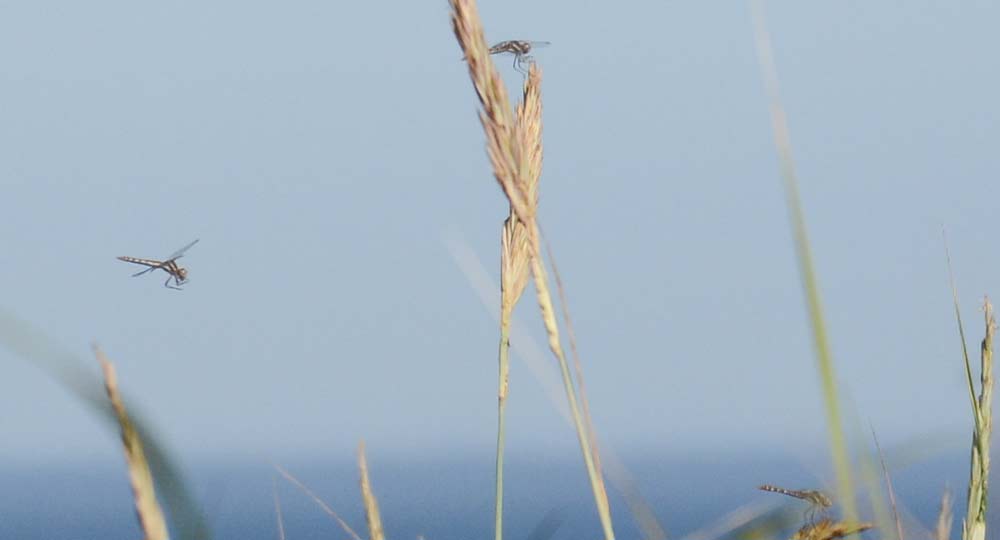
Tiffany Boothe / Seaside Aquarium
There was a group called the Migratory Dragonfly Partnership which offered an opportunity for people to collect and record dragonfly migration observations. However, that no longer seems to exist. Citizen scientists monitored the timing, duration, and direction of travel of migrating dragonflies, and noted any additional behaviors observed in migratory flight such as feeding or mating.
So, they remain a colorful mystery on the Washington coast and Oregon coast.
That includes the question: how long will they be around? That no one really knows, either. They sometimes return briefly in yet another wave.
Hotels in Seaside – Where to eat – Seaside Maps and Virtual Tours




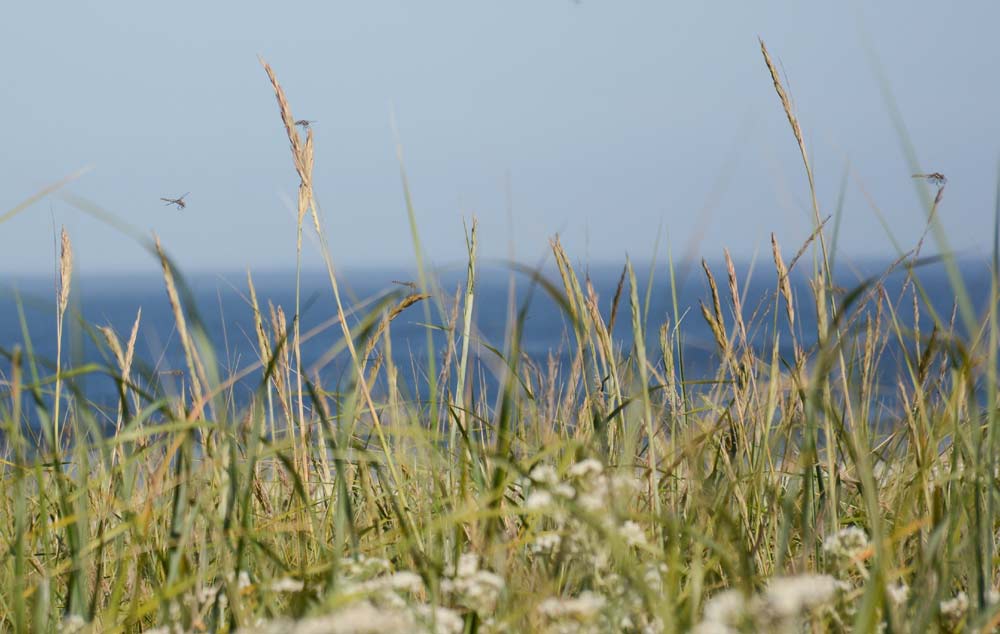
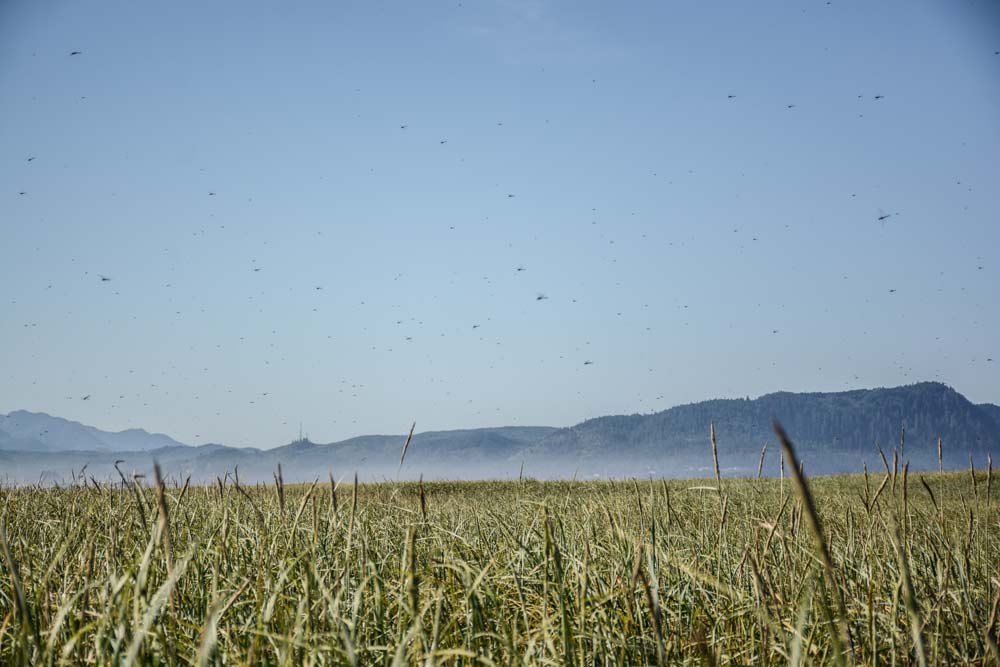
More About Oregon Coast hotels, lodging…..
More About Oregon Coast Restaurants, Dining…..
LATEST Related Oregon Coast Articles
Back to Oregon Coast
Contact Advertise on Oregon Coast Beach Connection
All Content, unless otherwise attributed, copyright Oregon Coast Beach Connection. Unauthorized use or publication is not permitted

Oregon
Oregon coast state park will reopen after 6-month closure
North Oregon coast travelers will get another beach option this spring.
Nehalem Bay State Park, which has been closed for more than six months, will reopen to the public May 23, the Oregon Parks and Recreation Department announced Wednesday — though the campground will remain closed through June.
The oceanfront park in Manzanita closed Nov. 1, 2024 to install new water and electrical lines, add restroom and shower buildings, renovate nine campsites to improve accessibility, and repave and add traffic calming improvements to the park entry road.
Improvements were paid for by Oregon-issued GO Bonds, approved by the Oregon Legislature in 2021. The $50 million investment is earmarked for nine park projects across the state, including Silver Falls and Smith Rock state parks.
Day-use areas, including the boat ramp, south day-use parking area, the airport and the multi-use path east of the main entrance road will reopen May 23, the parks department said. The main entrance on Garey Street in Manzanita will also reopen that day.
The campground and the Horizon Street entrance is scheduled to reopen July 1 at the earliest, park officials said. Campground reservations will open for July and beyond in the next few weeks, available online at oregonstateparks.reserveamerica.com.
–Jamie Hale covers travel and the outdoors and co-hosts the Peak Northwest podcast. Reach him at 503-294-4077, jhale@oregonian.com or @HaleJamesB.
Our journalism needs your support. Subscribe today to OregonLive.com.
Oregon
No. 7 Oregon State baseball good enough to earn sluggish win over Portland Pilots
CORVALLIS — Before the Oregon State baseball team played its final midweek game of the season, coach Mitch Canham strolled up to sophomore Laif Palmer with a simple question.
“How are we feeling?” he asked, assessing the readiness of his right-handed reliever.
“We’re in the last four games of the regular season,” Palmer replied. “We’ve got a week-and-a-half off after this. So, yeah, I’m good.”
Good enough, anyway. And that pretty much sums up the seventh-ranked Beavers’ 5-3 win over the Portland Pilots on Tuesday night at Goss Stadium. Oregon State was good enough.
James DeCremer had a solid performance in his first-career start, Palmer was dominant out of the bullpen, AJ Singer had a three-hit game and the Beavers (38-12-1) walked their way to a sluggish win before 3,542 in Corvallis.
Canham stopped himself mid-sentence from saying his team didn’t play well, but it was clear he left Goss longing for more from a group that found itself in a dogfight with the Pilots (21-27) well into the late innings Tuesday night.
When Singer and Canon Reeder smacked back-to-back run-scoring singles in the bottom of the fifth inning, it gave the Beavers a 3-1 lead and control of the game. But Tyce Peterson struck out with the bases loaded to end the inning without further damage, and the Pilots immediately responded in the top half of the sixth, using a Riley McCarthy two-run single to tie the game 3-3.
After playing 18 of the previous 21 games on the road or in neutral-site parks, it looked like the travel-weary Beavers might fade from there. Instead, they gutted out a gritty win with a pair of seventh-inning runs.
Wilson Weber started the rally with a one-out triple off the left field wall and Singer kept things going with an infield single, putting runners on the corners. Two batters later, Reeder drew a walk to load the bases and it was a prelude of things to come. Peterson followed with an eight-pitch walk, bringing home the go-ahead run, and three pitches later, Pilots reliever Kaden Starr plunked Dallas Macias in the back with a 2-0 fastball, giving Oregon State a 5-3 edge.
It proved to be enough for Palmer. The 6-foot-6 sophomore closed the game with 2 1/3 hitless innings, retiring all seven batters he faced on 27 pitches, to improve to 2-0 this season.
“I really liked what we all saw out of Palmer,” Canham said. “He’s just filling it up.”
The Beavers also saw a few nice things out of DeCremer.
The 6-2 redshirt freshman, who found out four hours before Tuesday’s first pitch that he would be making his first start, worked around a rough second inning to deliver a solid performance. He allowed one run on five hits and finished with three strikeouts in four innings, during which he threw 54 pitches, including 39 for strikes.
DeCremer was untouchable in the first inning, retiring the side in order on just seven pitches — all strikes — but had a bumpy second inning, giving up four hits and his only run. Portland cleanup hitter Zach Toglia led off the inning with a home run to left field, crushing a 2-1 pitch into the parking lot over the bullpen, and it seemed to momentarily rattle DeCremer. Cole Katayama-Stall followed with a single to right field, McCarthy ripped a double down the third base line, Henry Muench hit a pop-up to third base that Trent Caraway couldn’t handle, and, suddenly, the Pilots had the bases loaded with no outs.
But DeCremer didn’t bat an eye.
He worked out of the jam on just six pitches, using a pair of flyouts and a strikeout to escape further damage, then tossed scoreless innings in the third and fourth. DeCremer lobbied to return for the fifth, but was overruled by pitching coach Rich Dorman.
“Of course, you always try,” he said, smiling, when asked if he tried to talk his way into another inning. “But you have, like, 20 guys in the pen that can all do a really good job. So it doesn’t matter. We won.”
Singer finished 3 for 5 with two RBIs, delivering run-scoring singles in the first and fifth innings, and Aiva Arquette went 2 for 5, as two of the Beavers’ most consistent hitters produced more than half of the the team’s nine hits.
It wasn’t the prettiest win, but it was a win nonetheless, moving the Beavers to the doorstep of their final series of the regular season.
“We pulled it out, which is great,” Canham said. “But I still have extremely high expectations for what the guys need to do.”
Next up: The Beavers open a three-game series against the Long Beach State Dirtbags on Thursday night. First pitch is scheduled for 5:35.
— Joe Freeman | jfreeman@oregonian.com | 503-294-5183 | @BlazerFreeman | @freemanjoe.bsky.social | Subscribe to The Oregonian/OregonLive newsletters and podcasts for the latest news and top stories.
Oregon
North America’s only Bornean elephant lives at the Oregon Zoo
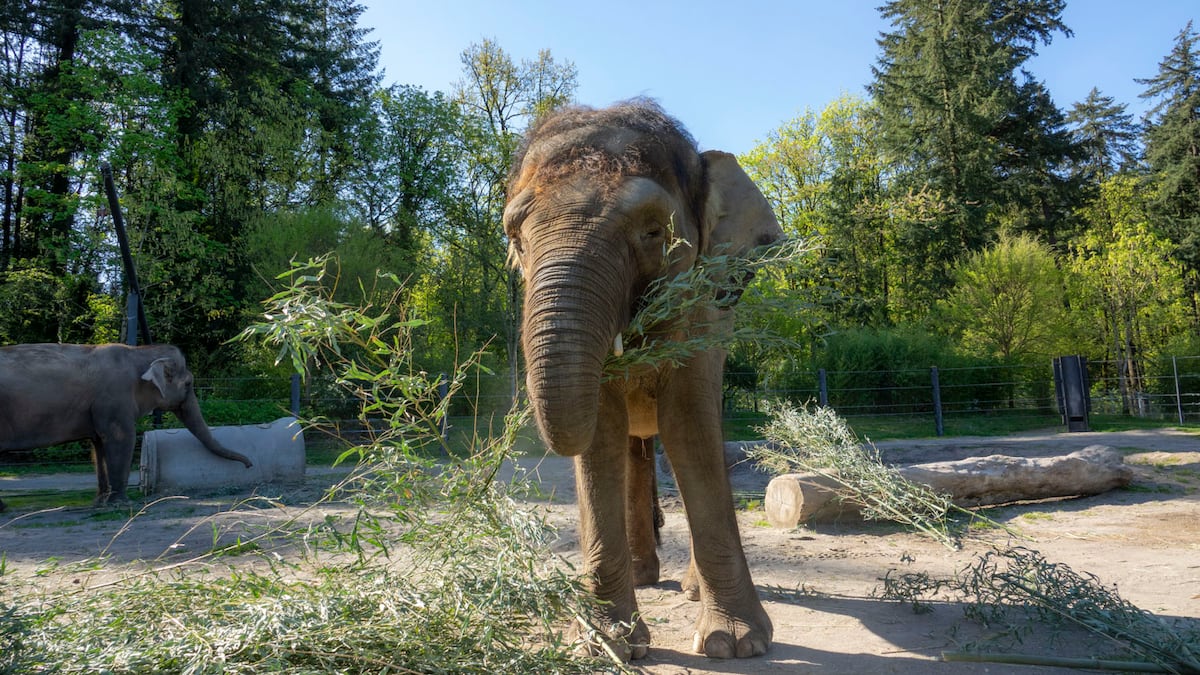
Bornean elephant Chendra browsing on bamboo at the Elephant Lands habitat in Oregon Zoo, Portland, Ore., on April 17, 2025.
Kathy Street / Oregon Zoo
Looking out at the herd of Oregon Zoo elephants, it’s easy to spot Chendra. With her petite stature, short trunk, larger ears and long tail, the Bornean elephant is markedly smaller than the rest. She’s also the only one of her kind on the entire North American continent.
Chendra, an elephant from northern Borneo in the Malaysian state of Sabah, arrived at the Oregon Zoo in 1999 and has remained in its care ever since.
Sharon Glaeser, who has a doctorate in animal welfare and conservation science, works as the elephant conservation lead for the Oregon Zoo. She recently appeared on OPB’s “Think Out Loud” to share more about why one of the world’s smallest elephants ended up in Portland.
“The Oregon Zoo Elephant Program was known around the world, and the Sabah Wildlife Department needed to find homes for some of the babies that had been orphaned,” Glaeser said in the interview. “They didn’t have facilities and they contacted the Oregon Zoo.”

Chendra, an elephant from northern Borneo in the Malaysian state of Sabah, arrived at the Oregon Zoo in 1999 and has remained in its care ever since. Borneo, an island in Southeast Asia’s Malay Archipelago, is shared by the Malaysian states of Sabah and Sarawak, Indonesian Kalimantan and the nation of Brunei.
Winston Szeto / OPB
Many Asian elephants are already under serious threat of extinction in their native countries and those in Borneo are especially at risk. Approximately 1,000 Bornean elephants are left in the world, and that number is decreasing, Glaeser noted.
“In our human care, they have their needs met,” Glaeser said. “They get food, they get resources, they have opportunities, they have safety, they have veterinary care, which is not something that wild animals are afforded in general.”
According to the World Wildlife Fund, Bornean elephants are the smallest Asian elephant subspecies and are distinctly smaller than their mainland Asia cousins.
They were determined by WWF to be genetically different from other Asian elephants — DNA evidence shows Bornean elephants were isolated from their cousins on mainland Asia and Sumatra, Indonesia, about 300,000 years ago. As a result, Bornean elephants evolved to have longer tails that sometimes touch the ground, as well as relatively large ears and straighter tusks when compared to other elephant subspecies.

From left to right: Sung-Surin, three month-old calf Tula-Tu, Rose-Tu and Chendra in Elephant Lands, April 28, 2025. Bornean elephants like Chendra are the smallest Asian elephant subspecies and are distinctly smaller than their mainland Asia cousins.
Tarah Bedrossian / Oregon Zoo
These island-dwelling elephants are known to roam large distances, sometimes covering up to 25 miles in a day, according to the International Fund for Animal Welfare.
Deforestation due to logging and palm oil production causes loss of habitat, the Oregon Zoo website says, which is the primary reason Bornean elephants are under threat. Plus, agricultural workers sometimes kill or injure elephants that raid their plantations and those actions can separate young elephants from their herds.
“In the past few years, the Sabah Wildlife Department has rescued 15 baby elephants, each less than a year old,” the zoo says. “All of them were found wandering alone in known human-elephant conflict areas along the east coast of Sabah. Chendra was orphaned this way.”
When Chendra was found, she had injuries to her front legs and left eye, and eventually became blind in that eye, according to the zoo. Since she was so young, the Sabah Wildlife Department couldn’t reunite Chendra with her herd or release her back into the wild, and instead opted to send her to the Oregon Zoo on Nov. 20, 1999.

Asian elephant Chendra, left, greets herdmates Sung-Surin, right, and Rose-Tu, in the background, at the Oregon Zoo on June 13, 2024.
Kathy Street / Oregon Zoo
The zoo currently funds two full-time elephant ranger positions with the Sabah Wildlife Rescue Unit and partners with the unit on several projects to create wildlife corridor habitat and reduce human-elephant conflict.
In 2020, the Oregon Zoo became part of the Bornean Elephant Action Plan, a 10-year-long project led by the Sabah Wildlife Department that is aimed at identifying threats and building strategies to address threats to endangered species. Among the species at risk are elephants, pangolin, sun bears, banteng, orangutans and more.
While the Oregon Zoo is well-known for its elephant program, it is not without criticism. Animal rights group Free the Oregon Zoo Elephants, or FOZE, has for years alleged the Oregon Zoo has an “aggressive elephant breeding program” and mistreats elephants, including Chendra. The zoo has denied these claims.
-

 Austin, TX5 days ago
Austin, TX5 days agoBest Austin Salads – 15 Food Places For Good Greens!
-

 Technology1 week ago
Technology1 week agoBe careful what you read about an Elden Ring movie
-

 Culture1 week ago
Culture1 week agoPulitzer Prizes 2025: A Guide to the Winning Books and Finalists
-

 Technology6 days ago
Technology6 days agoNetflix is removing Black Mirror: Bandersnatch
-

 Education1 week ago
Education1 week agoUniversity of Michigan President, Santa Ono, Set to Lead University of Florida
-

 World7 days ago
World7 days agoThe Take: Can India and Pakistan avoid a fourth war over Kashmir?
-

 News6 days ago
News6 days agoReincarnated by A.I., Arizona Man Forgives His Killer at Sentencing
-

 News1 week ago
News1 week agoJefferson Griffin Concedes Defeat in N.C. Supreme Court Race















